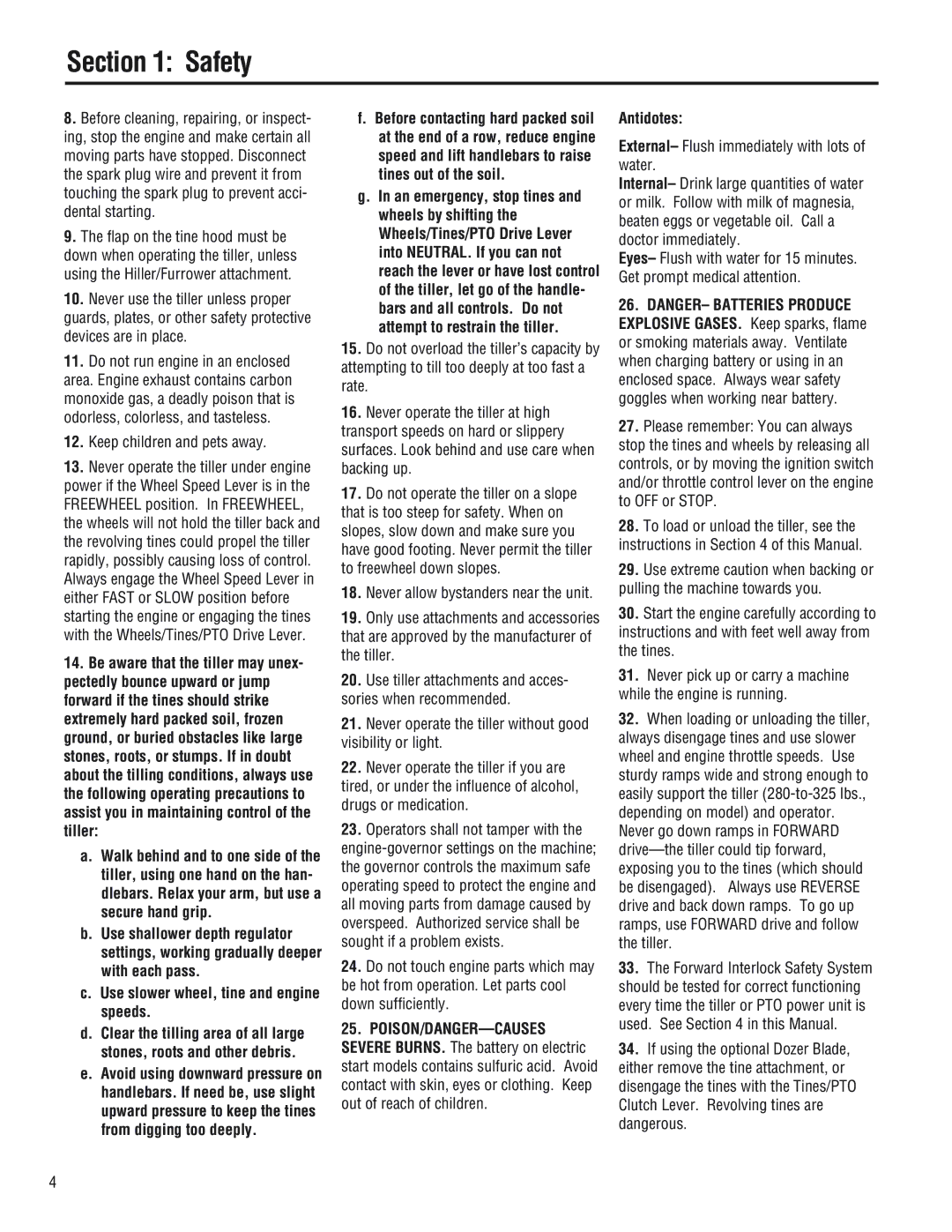8.Before cleaning, repairing, or inspect- ing, stop the engine and make certain all moving parts have stopped. Disconnect the spark plug wire and prevent it from touching the spark plug to prevent acci- dental starting.
9.The flap on the tine hood must be down when operating the tiller, unless using the Hiller/Furrower attachment.
10.Never use the tiller unless proper guards, plates, or other safety protective devices are in place.
11.Do not run engine in an enclosed area. Engine exhaust contains carbon monoxide gas, a deadly poison that is odorless, colorless, and tasteless.
12.Keep children and pets away.
13.Never operate the tiller under engine power if the Wheel Speed Lever is in the FREEWHEEL position. In FREEWHEEL, the wheels will not hold the tiller back and the revolving tines could propel the tiller rapidly, possibly causing loss of control. Always engage the Wheel Speed Lever in either FAST or SLOW position before starting the engine or engaging the tines with the Wheels/Tines/PTO Drive Lever.
14.Be aware that the tiller may unex- pectedly bounce upward or jump forward if the tines should strike extremely hard packed soil, frozen ground, or buried obstacles like large stones, roots, or stumps. If in doubt about the tilling conditions, always use the following operating precautions to assist you in maintaining control of the tiller:
a.Walk behind and to one side of the tiller, using one hand on the han- dlebars. Relax your arm, but use a secure hand grip.
b.Use shallower depth regulator settings, working gradually deeper with each pass.
c.Use slower wheel, tine and engine speeds.
d.Clear the tilling area of all large stones, roots and other debris.
e.Avoid using downward pressure on handlebars. If need be, use slight upward pressure to keep the tines from digging too deeply.
f.Before contacting hard packed soil at the end of a row, reduce engine speed and lift handlebars to raise tines out of the soil.
g.In an emergency, stop tines and wheels by shifting the Wheels/Tines/PTO Drive Lever into NEUTRAL. If you can not reach the lever or have lost control of the tiller, let go of the handle- bars and all controls. Do not attempt to restrain the tiller.
15.Do not overload the tiller’s capacity by attempting to till too deeply at too fast a rate.
16.Never operate the tiller at high transport speeds on hard or slippery surfaces. Look behind and use care when backing up.
17.Do not operate the tiller on a slope that is too steep for safety. When on slopes, slow down and make sure you have good footing. Never permit the tiller to freewheel down slopes.
18.Never allow bystanders near the unit.
19.Only use attachments and accessories that are approved by the manufacturer of the tiller.
20.Use tiller attachments and acces- sories when recommended.
21.Never operate the tiller without good visibility or light.
22.Never operate the tiller if you are tired, or under the influence of alcohol, drugs or medication.
23.Operators shall not tamper with the engine-governor settings on the machine; the governor controls the maximum safe operating speed to protect the engine and all moving parts from damage caused by overspeed. Authorized service shall be sought if a problem exists.
24.Do not touch engine parts which may be hot from operation. Let parts cool down sufficiently.
25.POISON/DANGER—CAUSES SEVERE BURNS. The battery on electric start models contains sulfuric acid. Avoid contact with skin, eyes or clothing. Keep out of reach of children.
Antidotes:
External– Flush immediately with lots of water.
Internal– Drink large quantities of water or milk. Follow with milk of magnesia, beaten eggs or vegetable oil. Call a doctor immediately.
Eyes– Flush with water for 15 minutes. Get prompt medical attention.
26.DANGER– BATTERIES PRODUCE EXPLOSIVE GASES. Keep sparks, flame or smoking materials away. Ventilate when charging battery or using in an enclosed space. Always wear safety goggles when working near battery.
27.Please remember: You can always stop the tines and wheels by releasing all controls, or by moving the ignition switch and/or throttle control lever on the engine to OFF or STOP.
28.To load or unload the tiller, see the instructions in Section 4 of this Manual.
29.Use extreme caution when backing or pulling the machine towards you.
30.Start the engine carefully according to instructions and with feet well away from the tines.
31.Never pick up or carry a machine while the engine is running.
32.When loading or unloading the tiller, always disengage tines and use slower wheel and engine throttle speeds. Use sturdy ramps wide and strong enough to easily support the tiller (280-to-325 lbs., depending on model) and operator. Never go down ramps in FORWARD drive—the tiller could tip forward, exposing you to the tines (which should be disengaged). Always use REVERSE drive and back down ramps. To go up ramps, use FORWARD drive and follow the tiller.
33.The Forward Interlock Safety System should be tested for correct functioning every time the tiller or PTO power unit is used. See Section 4 in this Manual.
34.If using the optional Dozer Blade, either remove the tine attachment, or disengage the tines with the Tines/PTO Clutch Lever. Revolving tines are dangerous.
